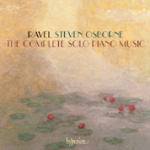Steven Osborne’s dazzling technique, musical intelligence, and attention to detail merit serious attention throughout his complete Ravel solo piano music cycle. In Gaspard de la nuit, the right-hand ostinato pattern remains absolutely steady and even as Osborne shapes the music’s shimmering textural washes with minimum modification of pulse and maximum scrupulousness in regard to dynamic gradation and pedal effects. The same goes for Scarbo’s rapid runs and chordal leaps, as well as Gibet’s repeated B-flats and soft, floating sonorities, although Osborne’s basic tempo for the latter is a shade slow and draggy.
While Osborne’s Hyperion label-mate Angela Hewitt brings more nuance and tonal contrast to the Sonatine’s first movement, his adherence to the Menuet’s cross-rhythmic phrase groupings brings out the music’s woodwind-like character. His hard-hitting third movement also makes the differences between Animé and Agité audible without being obvious.
It’s worth citing several examples to illuminate how Osborne’s interpretations of Valses Nobles et Sentimentales, Le Tombeau de Couperin, and Miroirs have noticeably evolved since he recorded them back in 1997 for his debut solo disc on Musical Heritage Society. In Miroirs’ opening piece Noctuelles, the initial theme concludes with upward arpeggios that are buttoned by short staccato chords with a diminuendo underneath. Most pianists gently throw these chords away, yet Osborne’s articulation and timing vivifies their understated sting. Un barque sur l’océan is lighter and more multi-layered this time around, while Osborne’s less-impetuous unfolding of Alborada de gracioso pays off by way of sharper definition all around, plus repeated notes that couldn’t be more perfectly poised and contoured. By contrast, Osborne’s leaner, more clavecin-evocative Le Tombeau de Couperin sacrifices the earlier reading’s warmth and expressive inflections.
However, the short pieces all emerge in fresh pianistic garb. For example, Osborne’s careful distinction between legato and detached articulation help shape the Menuet antique’s canonic writing more than in most recordings, while similar contrapuntal clarity distinguishes his brisk and clipped rendition of the Menuet sur le nom d’Haydn. And his fluent, often understated Pavane pour une infante défunte allows the music to speak for its touching self. Conversely, Osborne lets his hair down in La Valse, sprucing up Ravel’s keyboard writing, indulging in teasingly appropriate rubatos and pushing the climaxes to their most exciting extreme. The performance may not match Roger Muraro’s colorful nonchalance and diablerie, but it’s an impressive piece of work all the same. Even in a catalog overrun with world-class Ravel cycles, the best of Osborne’s work merits serious consideration.
































